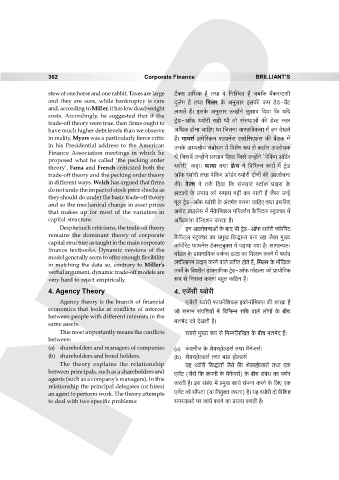Page 362 - Corporate Finance PDF Final new link
P. 362
NPP
362 Corporate Finance BRILLIANT’S
stew of one horse and one rabbit. Taxes are large Q>¡³g A{YH$ h¡ VWm do {ZpíMV h¢ O~{H$ ~¢H$aßQ>gr
and they are sure, while bankruptcy is rare Xþb©^ h¡ VWm {‘ba Ho$ AZwgma BgH$s H$‘ S>oS>-d¡Q>
and, according to Miller, it has low dead-weight
bmJV| h¢& BgHo$ AZwgma CÝhm|Zo gwPmd {X¶m {H$ ¶{X
costs. Accordingly, he suggested that if the
trade-off theory were true, then firms ought to Q´>oS>-Am°’$ ϶moar ghr Wr Vmo g§ñWmAm| H$s S>oãQ> ñVa
have much higher debt levels than we observe A{YH$ hmoZm Mm{hE Wm {OVZm dmñV{dH$Vm ‘| h‘ XoIVo
in reality. Myers was a particularly fierce critic h¢& ‘m¶g© A‘o[aH$Z ’$m¶Z|g Egmo{gEe§g H$s ~¡R>H$ ‘|
in his Presidential address to the American CZHo$ Aܶjr¶ g§~moYZ ‘| {deof ê$n go H$R>moa AmbmoMH$
Finance Association meetings in which he Wo {Og‘| CÝhm|Zo àñVmd {X¶m {Ogo CÝhm|Zo 'noqH$J Am°S>©a
proposed what he called ‘the pecking order
theory’. Fama and French criticized both the ϶moar' H$hm& ’$m‘m VWm ’«|$M Zo {d{^ÝZ ê$nm| ‘| Q´>oS>
trade-off theory and the pecking order theory Am°’$ ϶moar VWm noqH$J Am°S>©a ϶moar XmoZm| H$s AmbmoMZm
in different ways. Welch has argued that firms H$s& doëM Zo VH©$ {X¶m {H$ g§ñWmE§ ñQ>m°H$ àmBg Ho$
do not undo the impact of stock price shocks as
PQ>H$m| Ho$ à^md H$mo g‘má Zht H$a nmVr h¢ O¡gm CÝh|
they should do under the basic trade-off theory
and so the mechanical change in asset prices ‘yb Q´>oS>-Am°’$ ϶moar Ho$ A§VJ©V H$aZm Mm{hE VWm Bg{bE
that makes up for most of the variation in AgoQ> àmBgog ‘| ‘¡Ho${ZH$b n[adV©Z H¡${nQ>b ñQ´>³Ma ‘|
capital structure. A{YH$m§e do[aEeZ H$aVm h¡&
Despite such criticisms, the trade-off theory BZ AmbmoMZmAm| Ho$ ~mX ^r Q´>oS>-Am°’$ ϶moar H$m°nm}aoQ>
remains the dominant theory of corporate H¡${nQ>b ñQ´>³Ma H$m à‘wI {gÕmÝV ~Zm ahm O¡gm ‘w»¶
capital structure as taught in the main corporate H$m°nm}aoQ> ’$m¶Z|g Q>o³ñQ>~w³g ‘| n‹T>m¶m J¶m h¡& gm‘mݶV…
finance textbooks. Dynamic versions of the ‘m°S>b Ho$ S>m¶Zm{‘H$ dO©Ýg S>mQ>m H$m {‘bmZ H$aZo ‘| n¶m©á
model generally seem to offer enough flexibility
in matching the data so, contrary to Miller's bMrbmnZ àXmZ H$aZo dmbo àVrV hmoVo h¢, {‘ba Ho$ ‘m¡{IH$
verbal argument, dynamic trade-off models are VH$m] Ho$ {dnarV S>m¶Zm{‘H$ Q´>oS>-Am°’$ ‘m°S>ëg H$mo àm¶mo{JH$
very hard to reject empirically. ê$n go {ZañV H$aZm ~hþV H${R>Z h¡&
4. Agency Theory 4. EO|gr ϶moar
Agency theory is the branch of financial EO|gr ϶moar ’$m¶Z|{e¶b BH$moZm°{‘³g H$s emIm h¡
economics that looks at conflicts of interest Omo g‘mZ g§n{Îm¶m| ‘| {d{^ÝZ é{M dmbo bmoJm| Ho$ ~rM
between people with different interests in the
same assets. ‘V^oX H$mo XoIVr h¡&
This most importantly means the conflicts g~go ‘w»¶ ê$n go {ZåZ{b{IV Ho$ ~rM ‘V^oX h¢…
between:
(a) shareholders and managers of companies (a) H§$nZrO Ho$ eo¶ahmoëS>g© VWm ‘¡ZoOg©&
(b) shareholders and bond holders. (b) eo¶ahmoëS>g© VWm ~m§S> hmoëS>g©
The theory explains the relationship ¶h ϶moar {gÕm§Vm| O¡go {H$ eo¶ahmoëS>g© VWm EH$
between principals, such as a shareholders and EO|Q> (O¡go {H$ H§$nZr Ho$ ‘¡ZoOg©) Ho$ ~rM g§~§Y H$m dU©Z
agents (such as a company's managers). In this
H$aVr h¡& Bg g§~§Y ‘| à‘wI H$m¶© g§nÝZ H$aZo Ho$ {bE EH$
relationship the principal delegates (or hires)
EO|Q> H$mo gm¢nVm (¶m {Z¶w³V H$aVm) h¡& ¶h ϶moar Xmo {d{eï>
an agent to perform work. The theory attempts
to deal with two specific problems: g‘ñ¶mAm| na H$m¶© H$aZo H$m n«¶mg H$aVr h¡…

